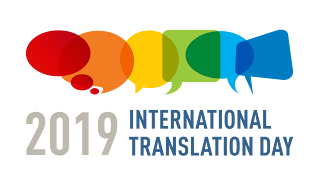Saint Jerome’s link with International Translation Day
It may surprise you but even we -translators- have our international day! It takes place on 30 September and takes root in Saint Jerome’s life.
.
 |
| https://www.un.org/en/events/translationday/ |
Saint Jerome's life and its importance for
translators
Jerome was
born around 347AD in the village of Stridon (now in Slovenia or Croatia).
Baptized around 365, he became a Christian priest a decade later and was
afterwards appointed Pope Damasus I’s, personal
secretary. Damasus made Jerome responsible for creating a new Latin version of
the Bible after the saint noticed many errors in the existing version
translated from Greek. Jerome produced
– after more than 40 years– what was viewed as a better "error-free"
Latin version named Vulgate. He used the Bible’s Hebrew text that he considered
the closest to Jesus’ original message. Vulgate means common text as the priest
used a poor in quality Latin to make the Bible understandable by everyone.
Jerome died in 420 but his work stayed the official edition of the Bible- used
for subsequent translations into other languages- for over a thousand years (until
1530). Thanks to his work, he was
officially named a Doctor of the Church by Pope Boniface VIII around 1298.
Jerome was canonized around 1588, which is probably when his official feast day
– 30 September- was marked. Due to his translation
of the Bible, he is mainly considered the patron saint of translation. However,
he is also said to give patronage to librarians, archivists and students. A fun fact about Saint Jerome is that he is
often represented with the red habit and red hat of a cardinal, even though the
function was created after his death.
 |
Detail from an alterpiece c.1467 by Carlo Crivelli, National Gallery, London
(https://www.flickr.com/photos/paullew/21214836483) |
Why should Saint Jerome matter to modern
translators?
- By advocating for the use of the original Hebrew text rather than the more reputable Greek translation, Jerome gives precedence to primary sources rather than second-hand sources as the best translation sources. This question of sources is indeed an important one as it is where the translation process begins.
- Faced with criticisms after using a Hebrew source, Jerome alluded to the necessity of balancing “verbum e verbo” translation (“the word from the word”, or literal translation) and “”sensum exprimere de sensu” translation(“to express the sense from the sense”, or free translation). One of the struggles of translators is indeed to know when they can get away from the text and when they cannot. Moreover, Jerome remarked on his translating strategy that he gave up “sense for sense” translation especially where “ubi et verborum ordo mysterium est” that is to say ‘”in those places where even the order of the words is a mysterium”. In other words, the saint seems to refer to the problem of adapting a word that does not have an equivalency in another language: is it better to find an equivalent or to leave the word in its original language and explain it in parenthesis? As far as he is concerned, Jerome used neologisms and left words in Hebrew. Moreover, the word mysterium has no official translation, which only seems to emphasize the point.
International day’s creation and its
operation
 |
| https://www.fit-ift.org/international-translation-day/ |
As mentioned, Saint Jerome’s Day is not new and has been celebrated by translators and interpreters for years on the days and weeks nearest to 30 September. Indeed - since its creation in 1953 -the International Federation of Translators (FIT-IFT) always encouraged the celebration of Saint Jerome. It was not until 1991 that FIT-IFT launched the idea of an International Translation Day to join forces in promoting translation in the members’ countries and display pride in the profession. However, it was only on 24 May 2017 that the United Nations General Assembly unanimously adopted a resolution which recognizes 30 September as UN International Translation Day. The day is to be celebrated across the entire UN network in order to recognize the “role of professional translation in connecting nations, and fostering peace, understanding and development”.
 |
https://www.sft.fr/fo/public/menu/archives_news/news_fiche&newsId=2484
|
How does it work?
- Internationally, the FIT-IFT annually choose a unifying theme and then hold a competition to design a poster that FIT-IFT members will be able to use to promote the day. 2019’s theme was Translation and Indigenous Languages.
- Locally, each Translation Federation choses which actions are to be held. For example, in France, the SFT (Society of French Translators) - counting around 1 600 professionals- decided to hold a decentralized programme - from 21 September to 12 October -with 13 events open to the public in cities such as Lille, Paris and Montebeliard. In Grenoble, the SFT held an escape game followed by pre-dinner drinks on 30 September.
Written by Anaïs P.
Sources:
https://www.rosettatranslation.com/patron-saint-translation/
https://www.sft.fr/fo/public/menu/archives_news/news_fiche&newsId=2484
http://fr.lpj.org/2014/09/30/fete-saint-jerome-30-septembre/
http://lapremiereporte.canalblog.com/archives/2006/10/19/2944970.html
https://www.societetraduction.fr/journee-mondiale-de-traduction-fierte-dune-profession/
http://jpdiacre.over-blog.com/article-30-septembre-saint-jerome-saint-patron-des-traducteurs-112199186.html
https://www.un.org/fr/events/translationday/
http://wiki.proz.com/wiki/index.php/International_Translation_Day
https://www.fit-ift.org/fit-timeline/
http://saintdujour.info/saint-jerome/



Thank you for choosing this topic!
RépondreSupprimerI cannot follow you in all your views, because the Vulgate is not an error-free Latin version of the Holy Bible, there are still some mistakes. For exemple, Saint Jerome's mistake began the tradition of depicting the prophet Moses with horns on his head (Exodus chapter 34, specifically verses 29, 30 and 35, in which Moses returns to the people after receiving the commandments for the second time). You also can see the result of this mistake on sculpture of Michelangelo' Moses in Rome. This was Jerome's effort to faithfully translate the difficult, original Hebrew text. As you know, Jewish writing is consonant, i.e. all 22 letters of the alphabet are used to indicate consonants only. When Moses descended from Mount Sinai, radiance emanated from his head (Heb. Karan). However st. Jerome, not well versed in Hebrew, read this word as keren ("horned").
Of course, Saint Jerome did an incredible job despite everything and he deserves being the translator's promoter.
The question is what is the best translation of the Bible? Does it exist? Do we need new translations of the Bible nowadays?
Hi !
SupprimerThank you for commenting !
Ah, I agree with you, actually! I read during my research that some scholars think Jerome did not in the end used the original Hebrew text as he was not well versed enough in Hebrew.. He also faced criticisms in his time for his translation. However, I could not mention it in the article as it would have been too long otherwise... I will add something to show this opinion is subjective.
But your informations is very interesting to know !
Honestly, I cannot really answer your questions, being atheist myself. However, I am of the advice that true perfection is difficult to achieve , especially in translation where words have various meanings and the choice of a meaning depends on the translator. Moreover, I think there are still some indigenous languages that are not well-known and whose speakers may like a translation of the Bible for their own reasons...
Anaïs P.
Hi Anaïs!
RépondreSupprimerI learned a lot of interesting facts from your article. I always knew that Saint Jerome is patron saint of translators but I had no idea why. I agree with Tanya that the Vulgate is not error-free, but it is still the basic pillar of modern translation. Likewise, there are also some mistakes in the translation of the Septuagint. Jerome showed us the difference between literal and free translation and highlighted the importance of sources.
Did you celebrate the ITD this year?
Anezka T.
Hi Anezka !
SupprimerI am glad you learned something from my article, thanks for reading it !
Yeah it was not but it was thought as error -free by some people ( it was definitively thought as better than the previous translation).
I wanted to celebrate it and do the escape game . However, the meeting about internships was held at the same time so I had no choice except not going to the escape game.
Anaïs P.
Very nice blog post. Thanks for sharing such helpful content. Keep posting in future also.
RépondreSupprimerLocalization Companies in India
Lease Abstraction in Bangalore
E-learning Localization
Translation Companies in Mumbai
The article is very nice. Thanks for sharing.
RépondreSupprimerTranslation Company in Noida
Translation Company in Delhi
Very nice article. Thanks for sharing such nice blog post. Keep posting.
RépondreSupprimerTranslation Company in Delhi | Translation Services in Delhi
Very nice article. Thanks for sharing such helpful article.
RépondreSupprimerTranslation and Localization
Localization Companies in India
Translation Company in India
Very nice article. Thanks for sharing such helpful blog post.
RépondreSupprimerTranslation Company in India
Localization Companies in India
Voice Over Services in India